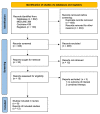Tai Chi Exercise for Mental and Physical Well-Being in Patients with Depressive Symptoms: A Systematic Review and Meta-Analysis
- PMID: 36833525
- PMCID: PMC9957102
- DOI: 10.3390/ijerph20042828
Tai Chi Exercise for Mental and Physical Well-Being in Patients with Depressive Symptoms: A Systematic Review and Meta-Analysis
Abstract
Tai Chi is a mindfulness-body practice that has physiological and psychosocial benefits and can be integrated into the prevention and rehabilitation of various medical conditions; however, the effectiveness of Tai Chi in the treatment of depression remains unclear. This review aimed to determine the effects of Tai Chi exercise on mental and physical well-being in patients with depressive symptoms. We searched databases for English language publications that appeared during January 2000-2022. The included trials were RCTs that involved people with depression with no other medical conditions, and included both adolescent and adult samples. A meta-analysis was performed using a random effects model and the heterogeneity was estimated using I2 statistics. The quality of each trial was assessed according to the Grades of Recommendation, Assessment, Development, and Evaluation (GRADE) methodology. The eight trials were divided into two comparisons: (1) a combination of Tai Chi and antidepressants versus standard antidepressants; (2) Tai Chi versus no intervention. The Tai Chi intervention showed improvements in mental and physical well-being as evidenced by the reductions in depression and anxiety and improved quality of life (QOL) of the patients with depressive symptoms. Further well-controlled RCTs are recommended with a precision trial design and larger sample sizes.
Keywords: Tai chi; depressive; mental well-being; physical well-being; randomized control trial.
Conflict of interest statement
The authors declare no conflict of interest.
Figures



 indicates low risk of bias,
indicates low risk of bias,  indicates high risk of bias and
indicates high risk of bias and  indicates unclear risk of bias.
indicates unclear risk of bias.





References
-
- WHO Depression. 2021. [(accessed on 15 January 2022)]. Available online: https://www.who.int/news-room/fact-sheets/detail/depression.
-
- Ferrari A.J., Charlson F., Norman R.E., Patten S., Freedman G.D., Murray C.J., Vos T., Whiteford H. Burden of Depressive Disorders by Country, Sex, Age, and Year: Findings from the Global Burden of Disease Study 2010. PLoS Med. 2013;10:e1001547. doi: 10.1371/journal.pmed.1001547. - DOI - PMC - PubMed
-
- Santomauro D.F., Herrera A.M.M., Shadid J., Zheng P., Ashbaugh C., Pigott D.M., Abbafati C., Adolph C., Amlag J.O., Aravkin A.Y., et al. Global prevalence and burden of depressive and anxiety disorders in 204 countries and territories in 2020 due to the COVID-19 pandemic. Lancet. 2021;398:1700–1712. doi: 10.1016/S0140-6736(21)02143-7. - DOI - PMC - PubMed
-
- Maciel-Saldierna M., Elizondo-Hernández E., Cervantes-Guevara G., Cervantes-Pérez E., Cervantes-Cardona G.A., Guzmán-Ramírez B.G., Brancaccio-Pérez I.V., Chejfec-Ciociano J.M., Guzmán-Ruvalcaba M.J., Cifuentes-Andrade L.R., et al. Prevalence of Depression, Anxiety, and Stress in Junior High School Students in Guadalajara, Mexico: A Cross-Sectional Survey Study. Int. J. Environ. Res. Public Health. 2022;19:15463. doi: 10.3390/ijerph192315463. - DOI - PMC - PubMed
Publication types
MeSH terms
LinkOut - more resources
Full Text Sources
Medical

